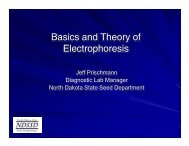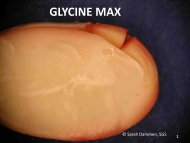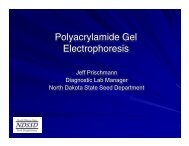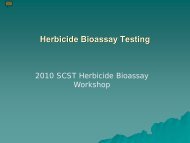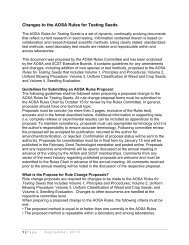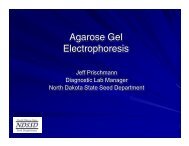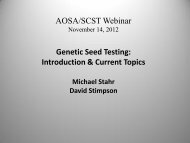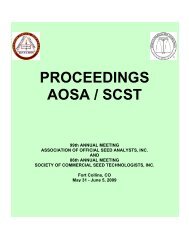Introduction to Glyphosate Mode of Action and Bioassay Calculations
Introduction to Glyphosate Mode of Action and Bioassay Calculations
Introduction to Glyphosate Mode of Action and Bioassay Calculations
You also want an ePaper? Increase the reach of your titles
YUMPU automatically turns print PDFs into web optimized ePapers that Google loves.
<strong>Introduction</strong> <strong>to</strong> <strong>Glyphosate</strong><br />
<strong>Mode</strong> <strong>of</strong> <strong>Action</strong> <strong>and</strong><br />
<strong>Bioassay</strong> <strong>Calculations</strong><br />
Michael Lovelace, Ph.D.<br />
Agronomist, USDA, AMS<br />
Seed Regula<strong>to</strong>ry <strong>and</strong><br />
Testing Branch<br />
Gas<strong>to</strong>nia, NC<br />
http://www.ams.usda.gov/lsg/seed.htm<br />
Agricultural Marketing Service<br />
Marketing <strong>and</strong> Regula<strong>to</strong>ry Programs
The Seed Regula<strong>to</strong>ry<br />
<strong>and</strong> Testing Branch<br />
AMS Lab <strong>and</strong> Office Complex, Gas<strong>to</strong>nia, NC<br />
• Enforces interstate commerce provisions <strong>of</strong><br />
the Federal Seed Act (FSA).<br />
• Provides the global seed community with<br />
services that promote the truthful marketing <strong>of</strong><br />
seed. Agricultural Marketing Service<br />
Marketing <strong>and</strong> Regula<strong>to</strong>ry Programs
The Seed Regula<strong>to</strong>ry<br />
<strong>and</strong> Testing Branch<br />
AMS Lab <strong>and</strong> Office Complex, Gas<strong>to</strong>nia, NC<br />
• ISTA accredited<br />
• ASL accreditation pending<br />
• ISO 9001 compliant<br />
Agricultural Marketing Service<br />
Marketing <strong>and</strong> Regula<strong>to</strong>ry Programs
SRTB Tests Performed<br />
• Purity<br />
• Germination<br />
• Noxious weed seed<br />
• Moisture / Conductivity<br />
• Species identification<br />
• Plant pathology<br />
• Variety verification<br />
– Varietal purity / Presence <strong>of</strong><br />
biotech derived seed<br />
• <strong>Bioassay</strong><br />
• Protein based<br />
• DNA based<br />
Agricultural Marketing Service<br />
Marketing <strong>and</strong> Regula<strong>to</strong>ry Programs<br />
New Test Development
New Test Development<br />
• Where do we begin?<br />
• Important things <strong>to</strong> know:<br />
– Previous literature / studies<br />
– Background on the crop<br />
– Background on the herbicide<br />
– Knowledge <strong>of</strong> experimental design /<br />
statistics<br />
Agricultural Marketing Service<br />
Marketing <strong>and</strong> Regula<strong>to</strong>ry Programs
Biochemistry Review<br />
Agricultural Marketing Service<br />
Marketing <strong>and</strong> Regula<strong>to</strong>ry Programs<br />
• What are:<br />
– Amino Acids?<br />
– Proteins?<br />
– Enzymes?
Amino Acids<br />
• An amino acid is any molecule<br />
containing amino <strong>and</strong> carboxylic<br />
acid functional groups.<br />
• AAs are the basic structural<br />
building units <strong>of</strong> proteins.<br />
• AA form short polymer chains<br />
called peptides or polypeptides,<br />
which in turn form proteins.<br />
• The coding sequences <strong>of</strong> genes<br />
determines the AA sequences <strong>of</strong><br />
almost all naturally occuring<br />
proteins though transcription<br />
<strong>and</strong> translation.<br />
Agricultural Marketing Service<br />
Marketing <strong>and</strong> Regula<strong>to</strong>ry Programs
Proteins<br />
• Protein comes from the Greek word<br />
"pro<strong>to</strong>s“, meaning "<strong>of</strong> primary<br />
importance". Proteins are essential <strong>to</strong><br />
the structure <strong>and</strong> function <strong>of</strong> all living<br />
cells.<br />
• Many proteins are enzymes or subunits<br />
<strong>of</strong> enzymes. Others are important for<br />
structural or mechanical roles,<br />
signalling functions, immune response,<br />
s<strong>to</strong>rage, <strong>and</strong> transport.<br />
• In nutrition, proteins are broken down<br />
through digestion <strong>to</strong> provide amino<br />
acids for an organism, including those<br />
the organism may not be able <strong>to</strong><br />
synthesise itself.<br />
Agricultural Marketing Service<br />
Marketing <strong>and</strong> Regula<strong>to</strong>ry Programs
Enzymes<br />
• An enzyme is a protein that catalyzes, or<br />
speeds up, a chemical reaction.<br />
• Enzymes are essential <strong>to</strong> life because<br />
most chemical reactions in biological<br />
cells occur <strong>to</strong>o slowly, or lead <strong>to</strong><br />
different products, without enzymes.<br />
• Enzymes lower the reaction activation<br />
energy, thus speeding up the reaction.<br />
They remain unaltered by the reaction<br />
<strong>and</strong>, therefore, can continue function.<br />
• Enzyme activity can be affected by other<br />
molecules. Inhibi<strong>to</strong>rs decrease or<br />
abolish enzyme activity, while activa<strong>to</strong>rs<br />
increase activity. Aspirin inhibits the<br />
COX enzymes that produce the<br />
inflamation messenger prostagl<strong>and</strong>in,<br />
thus suppressing pain <strong>and</strong> inflammation.<br />
Agricultural Marketing Service<br />
Marketing <strong>and</strong> Regula<strong>to</strong>ry Programs
H<br />
Amino Acid Synthesis<br />
NH 3 +<br />
R<br />
COO -<br />
• Carbon skele<strong>to</strong>ns come from<br />
intermediates <strong>of</strong> glycolysis, the<br />
pen<strong>to</strong>se phosphate pathway, or<br />
citric acid cycle. These<br />
skele<strong>to</strong>ns contain carboxylic<br />
acid groups.<br />
• Nitrogen is assimilated in<strong>to</strong><br />
amino acids by way <strong>of</strong> glutamate<br />
<strong>and</strong> glutamine.<br />
• Synthesize using five different<br />
precursors via various<br />
pathways.<br />
Agricultural Marketing Service<br />
Marketing <strong>and</strong> Regula<strong>to</strong>ry Programs
Alanine (Ala) Arginine (Arg)<br />
Aspargine (Asn) Aspartate (Asp)<br />
Cysteine (Cys)<br />
Glutamate (Glu) Glutamine (Gln)<br />
Methionine (Met)<br />
Branched Chain<br />
Amino Acids<br />
Aromatic<br />
Amino Acids<br />
Isoleucine (Ile)<br />
Amino Acids<br />
Proline (Pro)<br />
Glycine (Gly)<br />
Leucine (Leu)<br />
Histidine (His)<br />
Serine (Ser) Threonine (Thr)<br />
Valine (Val)<br />
Phenylalanine (Phe) Tyrosine (Tyr) Tryp<strong>to</strong>phan (Trp)<br />
Lysine (Lys)<br />
Inhibited by<br />
ALS Inhibiting<br />
Herbicides<br />
Inhibited by<br />
<strong>Glyphosate</strong>
D-Erythrose-4-Phosphate<br />
H 2 O<br />
P i<br />
7-Phospho-2-dehydro-<br />
3-deoxy-Darabinoheptulosonate<br />
NAD +<br />
NADH,<br />
H + , P i<br />
Shikimate Pathway<br />
Production <strong>of</strong> Aromatic Amino Acids<br />
3-Dehydroquinate<br />
Phosphoenolpyruvate<br />
O<br />
O -<br />
Enzyme<br />
complex<br />
O<br />
O- O- P<br />
O<br />
Co++<br />
3-Dehydroquinate<br />
synthase<br />
3-Dehydroquinate<br />
dehydratase<br />
H 2 O<br />
3-Dehydroshikimate<br />
Chorismate<br />
Shikimate<br />
dehydrogenase<br />
NADPH,<br />
H +<br />
NADP +<br />
3-Phospho-5-enoylpyruvylshikimate<br />
Chorismate<br />
synthase<br />
P i<br />
Shikimate<br />
3-Phospho-5enoylpyruvylshikimate<br />
synthase<br />
Mg++<br />
Shikimate<br />
kinase<br />
3-Phosphoshikimate<br />
(S3P)<br />
ATP<br />
ADP<br />
P i<br />
PEP
Chorismate<br />
Precursor for Aromatic Amino Acids<br />
Chorismate<br />
Prephenate Anthranilate<br />
Phenylalanine Tyrosine Tryp<strong>to</strong>phan
Influence <strong>of</strong> <strong>Glyphosate</strong> in Plants<br />
<strong>Glyphosate</strong> molecules<br />
in a spray droplet
Chloroplast<br />
O<br />
O -<br />
O<br />
O- O- P<br />
O<br />
Chorismate<br />
3-Phospho-5enoylpyruvylshikimate<br />
synthase<br />
Shikimate<br />
x
O -<br />
O -<br />
O<br />
P<br />
O<br />
O -<br />
P<br />
O -<br />
O<br />
PEP<br />
N<br />
Competitive Inhibition<br />
COO -<br />
<strong>Glyphosate</strong><br />
COO -<br />
EPSPS<br />
open conformation closed conformation
How does resistance work?<br />
Site <strong>of</strong> herbicide action<br />
in a conventional plant<br />
O -<br />
O<br />
P<br />
O -<br />
N<br />
<strong>Glyphosate</strong><br />
Interaction results in a conformational change that will not allow PEP <strong>to</strong> bind.<br />
Site <strong>of</strong> herbicide action<br />
in a transgenic plant<br />
O -<br />
O<br />
P<br />
O -<br />
N<br />
COO -<br />
<strong>Glyphosate</strong><br />
Changing a base pair that codes for an amino acid in the site <strong>of</strong> herbicide action<br />
changes the localized charges <strong>of</strong> the enzyme, thus inhibiting glyphosate binding.<br />
This permits PEP <strong>to</strong> bind <strong>and</strong> the shikimate pathway <strong>to</strong> function normally.<br />
COO -
How does this knowledge relate<br />
<strong>to</strong> bioassays?<br />
• <strong>Glyphosate</strong> activity occurs in<br />
the chloroplast. A light cycle<br />
must be present for<br />
glyphosate <strong>to</strong> have an affect.<br />
• Seeds do not have<br />
chloroplasts, so a certain<br />
level <strong>of</strong> plant development is<br />
necessary in order for the<br />
bioassay <strong>to</strong> work.<br />
• This is the reason we have<br />
some growth <strong>of</strong> the plants<br />
before growth is inhibited.<br />
Agricultural Marketing Service<br />
Marketing <strong>and</strong> Regula<strong>to</strong>ry Programs
Summary<br />
• <strong>Glyphosate</strong> translocates in<strong>to</strong><br />
the chlorophyll.<br />
• In the chlorophyll, glyphosate<br />
inhibits the EPSPS enzyme,<br />
thus inhibiting production <strong>of</strong><br />
aromatic amino acids.<br />
• Plants die due <strong>to</strong> starvation.<br />
• In transgenic plants, a mutated<br />
EPSPS enzyme is insensitive <strong>to</strong><br />
glyphosate, thus allowing PEP<br />
<strong>to</strong> bind normally.<br />
Agricultural Marketing Service<br />
Marketing <strong>and</strong> Regula<strong>to</strong>ry Programs
Time <strong>to</strong> Change Gears!!<br />
Agricultural Marketing Service<br />
Marketing <strong>and</strong> Regula<strong>to</strong>ry Programs
<strong>Bioassay</strong> Setup<br />
• Acquire sample seeds from purity<br />
test <strong>and</strong> count out the number <strong>of</strong><br />
seeds needed <strong>to</strong> conduct the test.<br />
– Sample in question<br />
• Roundup Treatment<br />
• Water Check<br />
– Know susceptible sample<br />
• Roundup Treatment<br />
• Water Check<br />
– Known resistant sample<br />
• Roundup Treatment<br />
• Water Check<br />
• Place the seeds in a petri-dishes <strong>and</strong><br />
correctly label the seeds for each<br />
treatment.
Prepare Working Solution<br />
• A working solution is the herbicide<br />
mixture used for seed soaking or<br />
wetting the <strong>to</strong>wels.<br />
• Determine the concentration <strong>of</strong> the<br />
working solution from the test<br />
directions <strong>and</strong> gather information from<br />
pesticide label.<br />
Agricultural Marketing Service<br />
Marketing <strong>and</strong> Regula<strong>to</strong>ry Programs
Preparation <strong>of</strong> Herbicide<br />
Working Solutions<br />
Prepare calculations for<br />
your herbicide working<br />
solution.<br />
Calculate concentration in<br />
PPM (Parts Per Million).<br />
or<br />
Calculate concentration in<br />
molarity (g / L).<br />
Agricultural Marketing Service<br />
Marketing <strong>and</strong> Regula<strong>to</strong>ry Programs
Short Quiz<br />
• What is a PPM?<br />
• How do you calculate PPM?<br />
• What are the units <strong>of</strong> PPM?<br />
• Why is PPM unit-less?
Gathering Pertinent Information<br />
• Locate the area on the<br />
container that contains the<br />
pertinent information<br />
• Identify the active ingredients<br />
<strong>and</strong> corresponding<br />
concentrations.<br />
• Know what information is<br />
useful.<br />
Agricultural Marketing Service<br />
Marketing <strong>and</strong> Regula<strong>to</strong>ry Programs
How much glyphosate is in 1<br />
Liter <strong>of</strong> Roundup?<br />
• Container indicates 50.2%<br />
glyphosate.<br />
• 50% <strong>of</strong> 1 liter is 500 ml, thus<br />
there are 500 ml <strong>of</strong><br />
glyphosate in 1 L.<br />
• The container indicates there<br />
are 600 ml <strong>of</strong> glyphosate in 1<br />
L.<br />
• Where did we go wrong?<br />
Agricultural Marketing Service<br />
Marketing <strong>and</strong> Regula<strong>to</strong>ry Programs
Why Not Calculate<br />
Based on Percentages?<br />
• Existing bioassay methods<br />
indicate concentration<br />
calculations should be<br />
based on percentage.<br />
• This can lead <strong>to</strong> problems<br />
because the label usually<br />
does not specify if<br />
percentages are based on<br />
weight or volume.<br />
• Why does it matter?<br />
Agricultural Marketing Service<br />
Marketing <strong>and</strong> Regula<strong>to</strong>ry Programs
Importance <strong>of</strong> Percentage Type<br />
50% V / V (volumetric)<br />
Solvent<br />
1.4 g / cm 3<br />
glyphosate<br />
1.7 g / cm 3<br />
If the<br />
solution is<br />
mixed on a<br />
volume<br />
basis,<br />
there will<br />
be about<br />
10% more<br />
glyphosate<br />
on a weight<br />
basis.<br />
50% g / g (gravimetric)<br />
Solvent<br />
1.4 g / cm 3<br />
glyphosate<br />
1.7 g / cm 3<br />
If the<br />
solution is<br />
mixed on a<br />
weight<br />
basis,<br />
there will<br />
be about<br />
10% more<br />
solvent on<br />
a volume<br />
basis.<br />
If we assume that the percentage <strong>of</strong> glyphosate is 50% by volume<br />
<strong>and</strong> glyphosate is actually 50% by weight, we would be adding 10%<br />
less roundup <strong>to</strong> our working solution than we would anticipate.
Why Not Calculate<br />
Based on Percentages?<br />
• So, is it volumetric or<br />
gravimetric??<br />
• We don’t always know!!<br />
• Instead, use g ai / Liter<br />
or lb ai / gal<br />
Agricultural Marketing Service<br />
Marketing <strong>and</strong> Regula<strong>to</strong>ry Programs
Calculating Working Solutions<br />
Determine the concentration <strong>of</strong><br />
your working solution <strong>and</strong> how<br />
much you will need for the<br />
experiment.<br />
Examine herbicide container <strong>to</strong><br />
establish concentration <strong>of</strong> s<strong>to</strong>ck<br />
solution.<br />
Calculate the dilution <strong>of</strong> your<br />
s<strong>to</strong>ck solution <strong>to</strong> make your<br />
desired working solution.<br />
Agricultural Marketing Service<br />
Marketing <strong>and</strong> Regula<strong>to</strong>ry Programs<br />
1000 PPM;<br />
1 Liter<br />
600 g / Liter<br />
???
Calculating Working Solutions in PPM<br />
1,000 parts<br />
999,000 parts<br />
1 part<br />
999 parts<br />
Roundup Ultra Max = 600 g ai<br />
1000 ml<br />
600 g ai<br />
1000 ml<br />
= 1 g ai<br />
cross multiply<br />
X<br />
Water 1 ml = 1 g<br />
1 g<br />
999 g<br />
= =<br />
=<br />
X =<br />
1 ml<br />
999 ml<br />
Must dilute roundup <strong>to</strong> acquire<br />
desired concentration.<br />
1 g ai X 1000 ml<br />
600 g ai<br />
X = 1.67 ml<br />
Add the 1.67 ml <strong>of</strong> herbicide solution <strong>to</strong> 998.33 ml <strong>of</strong> water <strong>to</strong> make a<br />
1000 PPM working solution.<br />
Are we done?? Not so fast!! There is still more <strong>to</strong> consider!!<br />
Agricultural Marketing Service<br />
Marketing <strong>and</strong> Regula<strong>to</strong>ry Programs
Calculating Working Solutions in PPM<br />
• Lets revisit the label.<br />
• The label indicates glyphosate is in<br />
the form <strong>of</strong> isopropylamine salt.<br />
• Why is this important?<br />
• The isopropylamine salt portion <strong>of</strong><br />
the formulation has no herbicidal<br />
activity. Furthermore, different<br />
formulations <strong>of</strong> glyphosate have<br />
different salts.<br />
• In order <strong>to</strong> avoid any confusion,<br />
our calculations need reflect the<br />
amount <strong>of</strong> glyphosate free acid<br />
(portion without the salt) in the<br />
solution.
Formulation Comparisons<br />
HO<br />
O<br />
O<br />
N P<br />
O -<br />
<strong>Glyphosate</strong> Free Acid (169 g / mole)<br />
+ H3 N<br />
Isopropylamine Salt (59 g / mole)<br />
• <strong>Glyphosate</strong> free acid = 169 g / mole<br />
• IPA salt <strong>of</strong> glyphosate = 228 g / mole<br />
• DAM salt <strong>of</strong> glyphosate = 201 g / mole<br />
• TMS salt <strong>of</strong> glyphosate = 244 g / mole
Calculating Working Solutions in PPM<br />
1,000 parts<br />
999,000 parts<br />
1 part<br />
999 parts<br />
1 g<br />
999 g<br />
= =<br />
=<br />
Roundup = 600 g IPA salt <strong>of</strong> glyphosate<br />
Ultra Max 1000 ml herbicide solution<br />
Roundup = 0.445 g glyphosate free acid<br />
Ultra Max ml herbicide solution<br />
0.445 g ai<br />
1 ml herb<br />
= 1 g ai<br />
X<br />
cross multiply<br />
Water 1 ml = 1 g<br />
X =<br />
1 g ai X 1 ml<br />
0.445 g ai<br />
1 ml<br />
999 ml<br />
X = 2.25 ml herb<br />
Due <strong>to</strong> the different densities <strong>of</strong> water <strong>and</strong> herbicide solution, it may not<br />
be appropriate <strong>to</strong> add 2.25 ml <strong>of</strong> herbicide solution <strong>to</strong> 997.75 ml <strong>of</strong> water.<br />
Instead, it would be more appropriate <strong>to</strong> tare a beaker on a balance.<br />
Add about half the quantity <strong>of</strong> water desired. Add your herbicide<br />
solution. Add water <strong>to</strong> the beaker until the scale reads 1000 grams.<br />
X<br />
169 g glyphosate free acid<br />
228 g IPA salt <strong>of</strong> glyphosate<br />
Herb solution 1 ml ≠ 1 g
Use <strong>of</strong> Molarity<br />
• Use g ai / Liter or lb ai / gal<br />
• Use molecular weight (169.07)<br />
<strong>of</strong> the glyphosate molecule.<br />
• Percentage, density <strong>of</strong><br />
solution, <strong>and</strong> makeup <strong>of</strong> inert<br />
ingredients is irrelevant in<br />
calculation.<br />
• <strong>Calculations</strong> are accepted SI<br />
units, whereas PPM is not.<br />
Agricultural Marketing Service<br />
Marketing <strong>and</strong> Regula<strong>to</strong>ry Programs
Conclusions<br />
• Things are not always as<br />
easy as they seem.<br />
• We need <strong>to</strong> rethink the way<br />
we do our calculations.<br />
• A common worksheet may<br />
st<strong>and</strong>ardize our herbicide<br />
solutions.<br />
• Molarity is a great<br />
alternative because there is<br />
no confusion with units.
Questions or Comments



